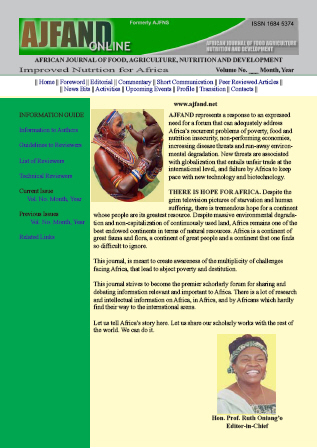
|
African Journal of Food, Agriculture, Nutrition and Development
Rural Outreach Program
ISSN: 1684-5358
EISSN: 1684-5358
Vol. 15, No. 4, 2015, pp. 10352-10367
|
 Bioline Code: nd15047
Bioline Code: nd15047
Full paper language: English
Document type: Research Article
Document available free of charge
|
|
|
African Journal of Food, Agriculture, Nutrition and Development, Vol. 15, No. 4, 2015, pp. 10352-10367
| en |
VEGETABLE PRODUCTION, CONSUMPTION AND ITS CONTRIBUTION TO DIETS ALONG THE URBAN – RURAL CONTINUUM IN NORTHERN GHANA
Chagomoka, Takemore; Drescher, A.; Glaser, R.; Marschner, B.; Schlesinger, J. & Nyandoro, G.
Abstract
Malnutrition continues to be a problem, with sub-Saharan Africa affected the worst. Women and children are at the pinnacle of this problem. The perpetual scourge of malnutrition in urban and periurban settings, coupled with levels of vegetable consumption below the recommended amounts, are a major problem in most African countries including West African cities. A household survey was conducted between November and December 2013 (dry season) in and around Tamale, Ghana as part of an urban food system analysis, to understand vegetable production and consumption and its contribution to household diets and income along the urban – rural continuum. Data collection was guided by a transect approach. A total of 240 households participated in the survey, with 62% males and 38% females. Additionally, 186 women of reproductive age (15 – 49 years) staying in the sampled households contributed to the computing of household dietary diversity through Women’s Dietary Diversity Scores (WDDS). Most vegetables produced were for subsistence use, considering that most households sold less than 50% of the crops and consumed the rest. Vegetable production varied significantly along the urban - rural continuum, with more households in rural areas producing all the requirements of their vegetables compared to urban and periurban areas. Nevertheless, the households in the rural areas (16%) had the lowest dietary diversity (≤ 3 WDDS) compared to urban areas (13%) and periurban areas (5%). The study showed low consumption of vegetables (especially the dark green vegetables) mostly in the rural area and limited diversity of vegetables, especially vitamin A rich vegetables and tubers, with only three vegetables (carrots, red pepper and sweet potato) consumed. There was evidence of more inclination toward staple crops compared to vegetables along the urban – rural continuum for both production and consumption, clearly shown in crops grown and food groups mostly consumed (cereals and tubers rather than dark green vegetables). There was overall low consumption of dark green leafy vegetables, such as amaranth, with only 26% reported to have consumed them during the reported period compared to food groups like cereals (98%). This study confirms the dual purpose of vegetables in complementing dishes (balanced diets) with much needed micronutrients and helping households along the urban – rural continuum to generate income.
Keywords
Vegetables; dietary diversity; food groups; urban - rural continuum; Northern Ghana
|
| |
© Copyright 2015 - African Journal of Food, Agriculture, Nutrition and Development
Alternative site location: http://www.ajfand.net/
|
|
